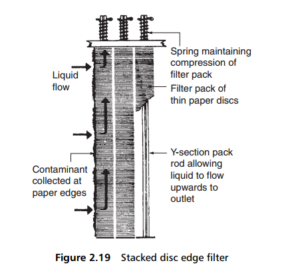0
-
An empty cart
You have no item in your shopping cart
envato-wordpress-toolkit domain was triggered too early. This is usually an indicator for some code in the plugin or theme running too early. Translations should be loaded at the init action or later. Please see Debugging in WordPress for more information. (This message was added in version 6.7.0.) in /var/www/wp-includes/functions.php on line 6121g5plus-darna domain was triggered too early. This is usually an indicator for some code in the plugin or theme running too early. Translations should be loaded at the init action or later. Please see Debugging in WordPress for more information. (This message was added in version 6.7.0.) in /var/www/wp-includes/functions.php on line 6121Edge filters involve the use of cartridge elements where the element is composed of a stack of discs or washers of paper, felt, plastic or metal, clamped together in compression. Liquid flow takes place from the outer edge inwards between the discs, which may be in intimate contact in the case of non-rigid disc materials, or through the controlled clearance space between individual discs, provided by spacing washers.
Such a construction has the advantage that the collected contaminant can be scraped from the upstream surface more easily and completely than it can be from a screen, and this cleaning can be performed during operation of the unit. In addition,
this type can be manufactured with inherent self-cleaning properties, so that cake build-up on the upstream surface can be virtually eliminated.
An edge filter element employing stacked paper discs is shown in Figure 2.19 . The pack of discs is held under compression by springs at the top of the assembly, so that the liquid undergoing filtration can only pass through the minute interstices
between the discs in layers of near molecular thickness. Virtually all solid impurities are, in fact, left on the edge of the discs since such an element can be capable of yielding an absolute cut-off of 1 um or less.
A further property of such an edge filter, employing unimpregnated paper discs, is that it can trap and retain finely dispersed water in fuels, oils or similar fluids. It is even possible to remove dissolved water by the provision of moderate heat and

vacuum. The presence of water will, however, substantially increase the back pressure of the filter due to the swelling of the discs, further restricting the clearance space available for flow. This can, if necessary, be used to operate a warning device
that water is present in the fluid being filtered.
It will also be appreciated that whilst the performance of such a paper element is often better than that of a pleated paper element, its normal resistance, and thus back-pressure is very much higher, or, size for size, its capacity is appreciably
less. However, it is one of the best types of filters for removing very fine solids from liquids, even colloidal graphite from oils. It is virtually immune to the effects of shock pressure and its element life is long, with a minimum of maintenance
requirements. Cleaning can usually be accomplished quickly and efficiently by a reverse flow of compressed air. The ultra-fine filtering properties may inhibit its use for particular applications due to the build-up of ultra-fine solids, restricting flow
where very fine and frequent cleaning is impractical.
The edge filter is thus mainly made of individual rings or discs stacked together, with spacers between them as required, or with dimples on the face of the disc to provide a flow channel. The same effect can be achieved by the use of a continuous helical ribbon or flat spring compressed together to give the required spacing between consecutive turns.
For further information, please click here.